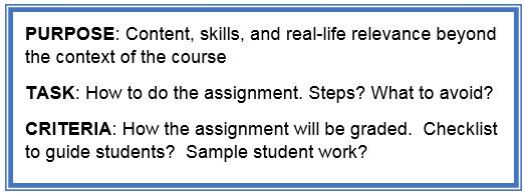
by Laurel Willingham-McLain, Director, Center for Teaching Excellence, Duquesne University
Imagine a simple practice you can do that strongly promotes student performance on assignments.
In several national studies of courses using transparency in learning and teaching, students report in pre/post surveys significantly increased academic confidence and sense of belonging compared to students in courses not using the transparent assignment design. This finding is statistically more significant for students from underserved populations. Prior research connects academic confidence and a sense of belonging with student persistence and grades (Winkelmes et al., 2016).
Transparent assignment design is a systematic way to be transparent about the purpose, task, and criteria of assignments to promote students’ learning. It can apply to all kinds of assignments, small and big. Focusing on these three components of assignments is beneficial to both faculty and students.

We invited Duquesne faculty who have implemented transparency over the past year or so to provide insights. Rebecca Cepek reflected on it in a recent post, Parallelograms and Poetry.
Some faculty told us they embrace transparent design because it builds on what they already do: “Smaller changes seem far better! They don’t lead to destroying things that are here, but build upon them. It’s not the ‘throw out’ culture and making change just for change sake.” “I can utilize the ideas I have and combine them with things others have already tried and validated. [This] gives me the language to discuss and understand the techniques I try in class.”
Transparent assignment design can help instructors develop confidence because it provides both structure and flexibility. One faculty member said this is “a very practical method to structure assignments.” Prior she had just been “trying to replicate assignments that other instructors had created.” By using the transparency framework, this instructor began to find her own teaching identity.
Students want to connect learning to their lives. One instructor noted that by explicitly calling attention to “how an assignment will relate to [students] now and in their future careers,” she can better demonstrate the meaning, value, and relevance of assignments. Another wrote: “Transparent assignment design has helped me make clear how exactly the assignments they complete in my class will prepare them for the future.”
Faculty noted that the exercise of implementing transparency helped them recognize how sometimes they weren’t even sure themselves what they expected students to get out of an assignment: “I haven’t always consciously stated (to myself) exactly why I want students to do certain assignments/tasks. […] I have come to better understand how each individual assignment I give contributes to the course’s learning goals.”
Respondents talked about imagining student perspectives: one person reported trying “to escape my own perspective more when designing even ‘straightforward’ (or so I think!) assignments.” Another reflected that “This design process has really helped me put myself in my students’ places so that I can make it crystal clear what I’m looking for in their work.”
Transparency surfaces confusion and knowledge/skill gaps. For instance, “when students complain about something I ask them to do, it isn’t necessarily because they don’t want to be challenged to learn new material; rather, it’s more likely they don’t understand either how to do the assignment or how the assignment contributes to their learning.” At first, the instructor equated transparency with hand-holding, but she now sees how being more explicit in helping students with the what, how, and why of an assignment can foster more rigorous learning because transparency has “removed the obstacle of figuring out why an assignment is important and opened the door to the real obstacle of learning the material.”
Finally, re-writing one or two assignments and seeing the resultant changes in students’ attitudes and performance energizes faculty to integrate transparency into other assignments, as well as into their communications with students during class, lab, and lectures.
Steve Hansen, Erin Rentschler and I recently submitted a chapter expanding on these perspectives for the forthcoming book, Transparent Design in Higher Education Teaching and Leadership (edited by Mary-Ann. Winkelmes, Allison Boye and Suzanne Tapp, Stylus Publishing).
Learn more
- Transparency in Learning and Teaching Project
- Berrett, Dan. “The unwritten rules of college.” The Chronicle of Higher Education 62.4 (2015): A26-A29.
- Winkelmes, M., Bernacki, M., Butler, J., Zochowski, M., Golanics, J., & Weavil, K. H. (2016). A teaching intervention that increases underserved college students’ success. Peer Review, 18(1), 31-36. Retrieved from https://search.proquest.com/docview/1805184428?accountid=10610.
- Winkelmes, M. (2013) Transparent Assignment Template.
- Kasey Christopher, PhD. “What Are We Doing and Why? Transparent Assignment Design Benefits Students and Faculty Alike.“
- Rebecca Cepek. “Parallelograms and Poetry: helping first generation students connect.“




I use clear statements of the purposes for all the cases I use, I task my students telling them the will be quizzed on the lessons that the cases provide, criteria for these cases are that they are relevant and material to essebtial knowledge of business law they need to avoid legal problems which have plgued others pursuing success in business
I found the second reading useful for understandind what I do To make the course transparent
LikeLike